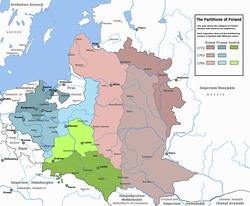Polish–Soviet War
The Polish–Soviet War (February 1919 – March 1921) was an armed conflict between Soviet Russia and Soviet Ukraine against the Second Polish Republic and the Ukrainian People's Republic. It was for control of what is now Ukraine and part of Belarus.
| Polish–Soviet War | |||||||||
|---|---|---|---|---|---|---|---|---|---|
| Part of Central and Eastern European military campaigns that included the Western Front of the Russian Civil War, Ukrainian War of Independence, Lithuanian Wars of Independence, Latvian War of Independence and Russian Civil War | |||||||||
 Top left: Polish FT-17 tanks of the 1st Tank Regiment during the Battle of Dyneburg, January 1920 Below left: Polish troops enter Kiev, May 1920 Top right: Polish Schwarzlose M.07/12 machine gun nest during the Battle of Radzymin, August 1920 Middle: Polish defences with a M1895/14 machine gun position near Miłosna, during the Battle of Warsaw, August 1920 Bottom left: Russian prisoners following the Battle of Warsaw Bottom right: Polish defences in Belarus during the Battle of the Niemen River, September 1920 | |||||||||
| |||||||||
| Belligerents | |||||||||
|
Support:
| |||||||||
| Commanders and leaders | |||||||||
| |||||||||
| Strength | |||||||||
|
Early 1919: ~50,000[5] Summer 1920: 800,000–950,000[6] 5 million reservists, Ukrainian Galician Army (about 1,000 soldiers), Socialist Soviet Republic of Lithuania and Belorussia |
Early 1919: ~80,000[7] Summer 1920: 348,286 troops on front,[8] about 700,000 reservists approx. 1,000,000[9] Ukraine: 20,000[10] Russian volunteers: 20,000[10] | ||||||||
| Casualties and losses | |||||||||
|
Total reported: 140,000–145,000 (unknown wounded not included) c. 60,000 dead[11] c. 80,000–85,000 captured[12] |
Total reported: 212,420 47,551 dead
51,351 captured or missing[13][14][15] | ||||||||
A formal peace treaty, the Peace of Riga, was signed on 18 March 1921. It divided the land between Poland and Soviet Russia. Much of the land that was given to Poland became part of the Soviet Union after World War II.
Polish–Soviet War Media
Partitions of Poland–Lithuania in 1795: the coloured territories show the extent of the Polish–Lithuanian Commonwealth just before the First Partition. The land absorbed by the Kingdom of Prussia is in blue (north-west), by the Austrian Habsburg monarchy in green (south) and by the Russian Empire in red (east).
Map of areas where Polish was used as a primary language in 1916 (published in post-1918 Poland)
Territorial establishment of the Second Polish Republic as of March 1919
Vladimir Lenin in 1919
Józef Piłsudski in 1919
Activists of the Polish Military Organisation in 1917
General Józef Haller swearing for the Polish flag when he was nominated to command the Blue Army
Notes
- ↑ Battle of Daugavpils
- ↑ 2.0 2.1 Volunteers
- ↑ There is disagreement over the dates of the war. The Encyclopædia Britannica begins its "Russo-Polish War" article with the date range 1919–1920 but then states, "Although there had been hostilities between the two countries during 1919, the conflict began when the Polish head of state Józef Piłsudski formed an alliance with the Ukrainian nationalist leader Symon Petlyura (21 April 1920) and their combined forces began to overrun Ukraine, occupying Kiev on 7 May." Some Western historians, including Norman Davies, consider mid-February 1919 the beginning of the war.[2] However, military confrontations between forces that can be considered officially Polish and the Red Army were already happening by late autumn 1918 and in January 1919.[3] The city of Vilnius, for example, was taken by the Soviets on 5 January 1919.[4]
References
- ↑ "Rumunia – zapomniany sojusznik" [Romania – a forgotten ally]. Chwała Zapomniana (in polski). 6 March 2019.
- ↑ Davies 2003, p. 22.
- ↑ Chwalba 2020, p. 13.
- ↑ "Wojna polsko-bolszewicka". Internetowa encyklopedia PWN (in polski). Archived from the original on 11 November 2013. Retrieved 27 October 2006.
- ↑ Davies 2003, p. 39.
- ↑ Davies 2003, p. 142.
- ↑ Davies 2003, p. 41.
- ↑ Bilans wojny polsko-bolszewickiej. Liczba żołnierzy, zabici, ranni i wzięci do niewoli
- ↑ Czubiński 2012, pp. 115–118.
- ↑ 10.0 10.1 Bilans wojny polsko-bolszewickiej. Liczba żołnierzy, zabici, ranni i wzięci do niewoli
- ↑ Rudolph J. Rummel (1990). Lethal politics: Soviet genocide and mass murder since 1917. Transaction Publishers. p. 55. ISBN 978-1-56000-887-3. Retrieved 5 March 2011.
- ↑ Chwalba 2020, pp. 306–307.
- ↑ Chwalba 2020, pp. 279–281.
- ↑ Davies, Norman (1972). White eagle, red star: the Polish-Soviet war, 1919–20. Macdonald and Co. p. 247. ISBN 978-0356040134. Retrieved 23 October 2011 – via Google Books.
- ↑ (in Polish) Karpus, Zbigniew, Alexandrowicz Stanisław, Waldemar Rezmer, Zwycięzcy za drutami. Jeńcy polscy w niewoli (1919–1922). Dokumenty i materiały (Victors Behind Barbed Wire: Polish Prisoners of War, 1919–1922: Documents and materials), Toruń, Wydawnictwo Uniwersytetu Mikołaja Kopernika w Toruniu, 1995, ISBN 978-83-231-0627-2.









